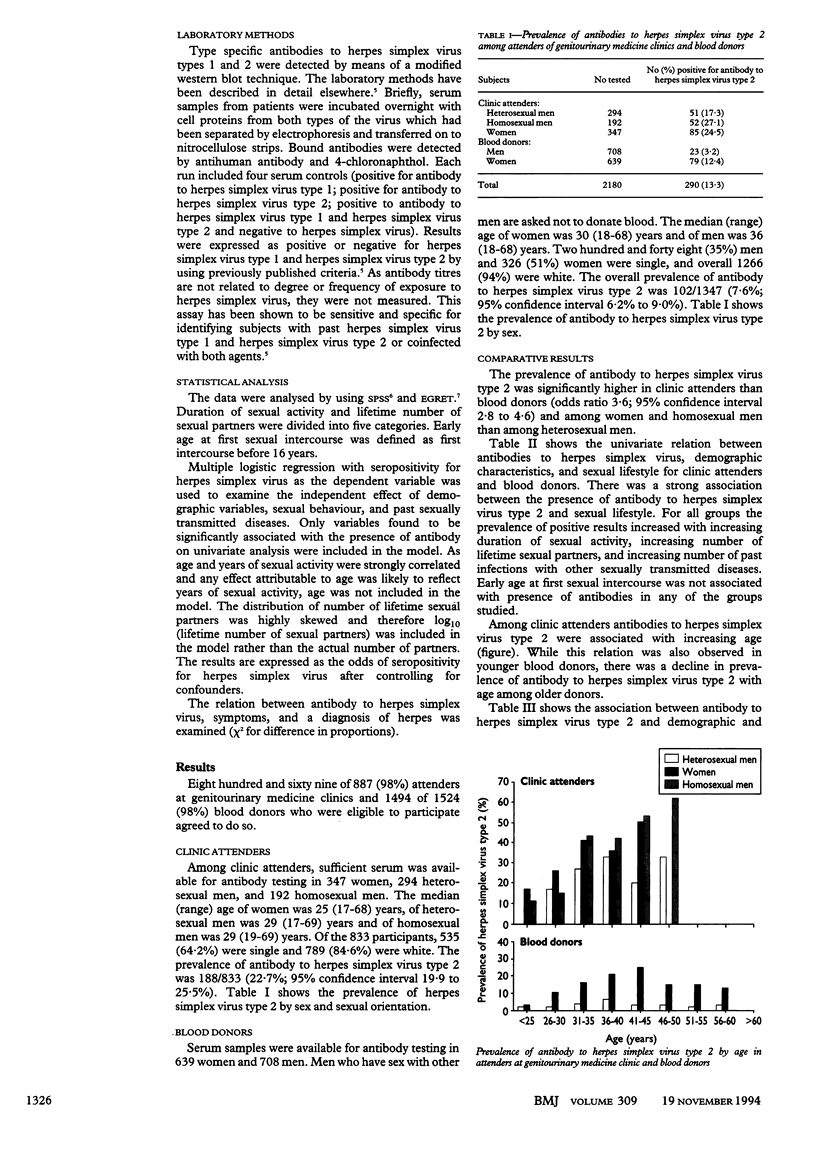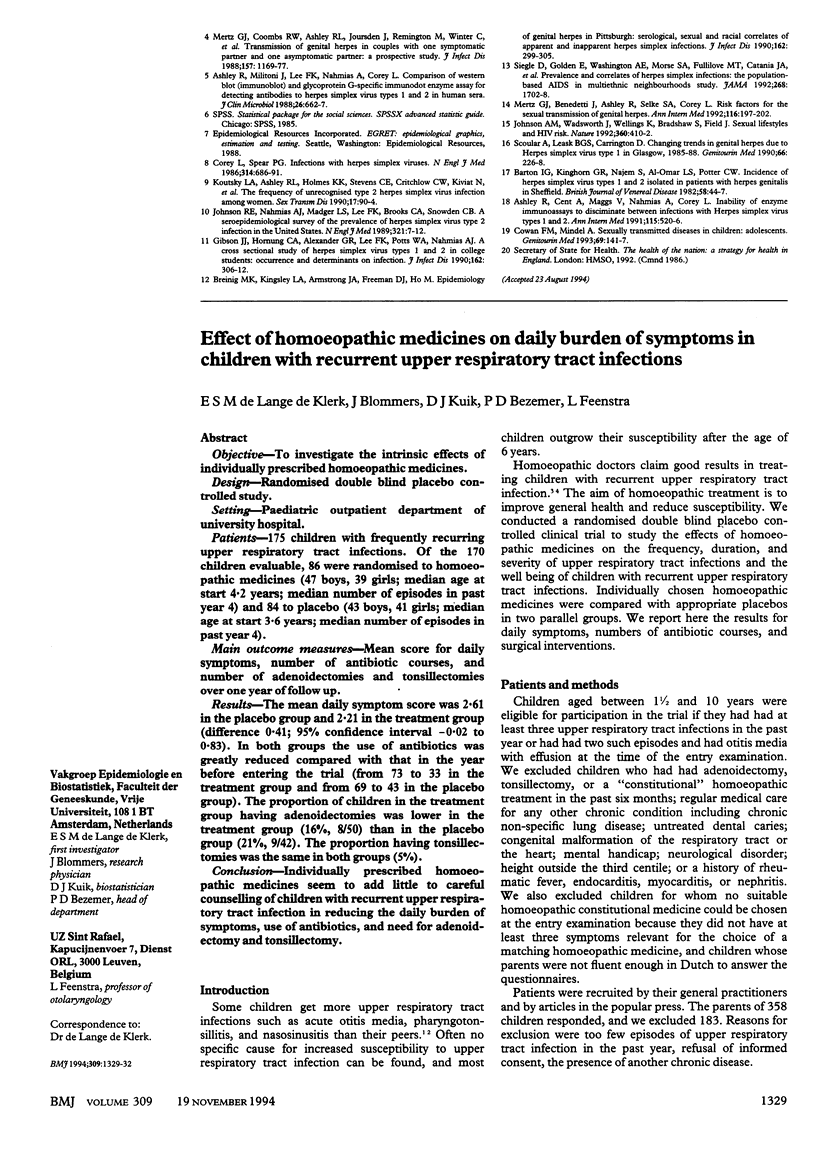Abstract
OBJECTIVES--To examine the epidemiology of antibody to herpes simplex virus type 2 and to assess its suitability as a serological marker of sexual behaviour in populations with high and low prevalences. DESIGN--Cross sectional survey. SETTING--Department of genitourinary medicine and blood donation centre in central London. SUBJECTS--Representative sample of 869 patients attending department between November 1990 and December 1991, and 1494 consecutive blood donors attending for donation between February and April 1992. METHOD--Participants had a blood sample taken for antibody testing with a novel type specific assay and completed a questionnaire. RESULTS--Prevalence of antibody differed significantly between the two groups (188/833 (22.7%) clinic attenders; 102/1347 (7.6%) blood donors). In both populations antibody was strongly associated with sex, sexual orientation, years of sexual activity, number of lifetime sexual partners, and past infection with sexually transmitted diseases after other factors were controlled for. Only 130 (45%) of all those with antibody had symptoms suggestive of genital herpes, and 79 (27.4%) had had genital herpes diagnosed. Of those without antibody to herpes simplex viruses type 1 and 2, 8.0% reported genital blisters or sores and 1.1% had had genital herpes diagnosed by a doctor. CONCLUSIONS--The strong relation between herpes simplex virus type 2 and sexual lifestyle suggests that the presence of antibody to the virus may be suitable for use as an objective, serological marker of patterns of sexual behaviour in different populations. These data show that only a minority of those infected with herpes simplex virus type 2 have a diagnosis of genital herpes or express clinical symptoms, making serological determinants of infection essential for epidemiological studies.
Full text
PDF




Selected References
These references are in PubMed. This may not be the complete list of references from this article.
- Ashley R. L., Militoni J., Lee F., Nahmias A., Corey L. Comparison of Western blot (immunoblot) and glycoprotein G-specific immunodot enzyme assay for detecting antibodies to herpes simplex virus types 1 and 2 in human sera. J Clin Microbiol. 1988 Apr;26(4):662–667. doi: 10.1128/jcm.26.4.662-667.1988. [DOI] [PMC free article] [PubMed] [Google Scholar]
- Ashley R., Cent A., Maggs V., Nahmias A., Corey L. Inability of enzyme immunoassays to discriminate between infections with herpes simplex virus types 1 and 2. Ann Intern Med. 1991 Oct 1;115(7):520–526. doi: 10.7326/0003-4819-115-7-520. [DOI] [PubMed] [Google Scholar]
- Barton I. G., Kinghorn G. R., Najem S., Al-Omar L. S., Potter C. W. Incidence of herpes simplex virus types 1 and 2 isolated in patients with herpes genitalis in Sheffield. Br J Vener Dis. 1982 Feb;58(1):44–47. doi: 10.1136/sti.58.1.44. [DOI] [PMC free article] [PubMed] [Google Scholar]
- Breinig M. K., Kingsley L. A., Armstrong J. A., Freeman D. J., Ho M. Epidemiology of genital herpes in Pittsburgh: serologic, sexual, and racial correlates of apparent and inapparent herpes simplex infections. J Infect Dis. 1990 Aug;162(2):299–305. doi: 10.1093/infdis/162.2.299. [DOI] [PubMed] [Google Scholar]
- Cowan F. M., Mindel A. Sexually transmitted diseases in children: adolescents. Genitourin Med. 1993 Apr;69(2):141–147. doi: 10.1136/sti.69.2.141. [DOI] [PMC free article] [PubMed] [Google Scholar]
- Gibson J. J., Hornung C. A., Alexander G. R., Lee F. K., Potts W. A., Nahmias A. J. A cross-sectional study of herpes simplex virus types 1 and 2 in college students: occurrence and determinants of infection. J Infect Dis. 1990 Aug;162(2):306–312. doi: 10.1093/infdis/162.2.306. [DOI] [PubMed] [Google Scholar]
- Johnson A. M., Wadsworth J., Wellings K., Bradshaw S., Field J. Sexual lifestyles and HIV risk. Nature. 1992 Dec 3;360(6403):410–412. doi: 10.1038/360410a0. [DOI] [PubMed] [Google Scholar]
- Johnson R. E., Nahmias A. J., Magder L. S., Lee F. K., Brooks C. A., Snowden C. B. A seroepidemiologic survey of the prevalence of herpes simplex virus type 2 infection in the United States. N Engl J Med. 1989 Jul 6;321(1):7–12. doi: 10.1056/NEJM198907063210102. [DOI] [PubMed] [Google Scholar]
- Koutsky L. A., Ashley R. L., Holmes K. K., Stevens C. E., Critchlow C. W., Kiviat N., Lipinski C. M., Wølner-Hanssen P., Corey L. The frequency of unrecognized type 2 herpes simplex virus infection among women. Implications for the control of genital herpes. Sex Transm Dis. 1990 Apr-Jun;17(2):90–94. doi: 10.1097/00007435-199004000-00009. [DOI] [PubMed] [Google Scholar]
- Mertz G. J., Benedetti J., Ashley R., Selke S. A., Corey L. Risk factors for the sexual transmission of genital herpes. Ann Intern Med. 1992 Feb 1;116(3):197–202. doi: 10.7326/0003-4819-116-3-197. [DOI] [PubMed] [Google Scholar]
- Mertz G. J., Coombs R. W., Ashley R., Jourden J., Remington M., Winter C., Fahnlander A., Guinan M., Ducey H., Corey L. Transmission of genital herpes in couples with one symptomatic and one asymptomatic partner: a prospective study. J Infect Dis. 1988 Jun;157(6):1169–1177. doi: 10.1093/infdis/157.6.1169. [DOI] [PubMed] [Google Scholar]
- Mertz G. J., Schmidt O., Jourden J. L., Guinan M. E., Remington M. L., Fahnlander A., Winter C., Holmes K. K., Corey L. Frequency of acquisition of first-episode genital infection with herpes simplex virus from symptomatic and asymptomatic source contacts. Sex Transm Dis. 1985 Jan-Mar;12(1):33–39. doi: 10.1097/00007435-198501000-00007. [DOI] [PubMed] [Google Scholar]
- Nahmias A. J., Lee F. K., Beckman-Nahmias S. Sero-epidemiological and -sociological patterns of herpes simplex virus infection in the world. Scand J Infect Dis Suppl. 1990;69:19–36. [PubMed] [Google Scholar]
- Scoular A., Leask B. G., Carrington D. Changing trends in genital herpes due to Herpes simplex virus type 1 in Glasgow, 1985-88. Genitourin Med. 1990 Jun;66(3):226–226. doi: 10.1136/sti.66.3.226. [DOI] [PMC free article] [PubMed] [Google Scholar]
- Siegel D., Golden E., Washington A. E., Morse S. A., Fullilove M. T., Catania J. A., Marin B., Hulley S. B. Prevalence and correlates of herpes simplex infections. The population-based AIDS in Multiethnic Neighborhoods Study. JAMA. 1992 Oct 7;268(13):1702–1708. [PubMed] [Google Scholar]


